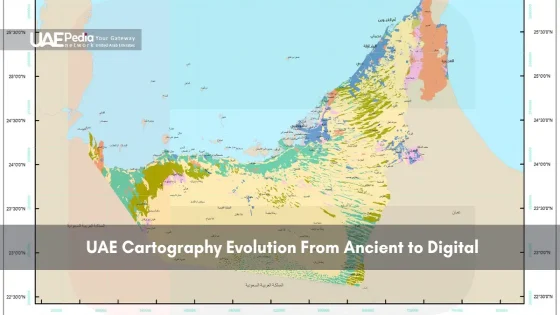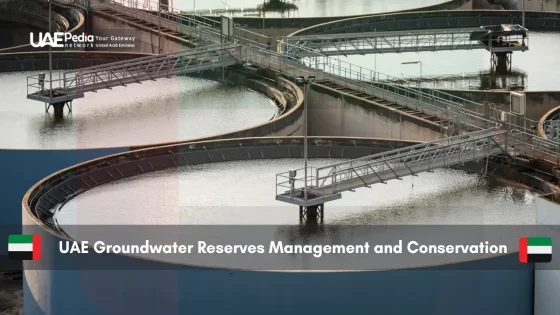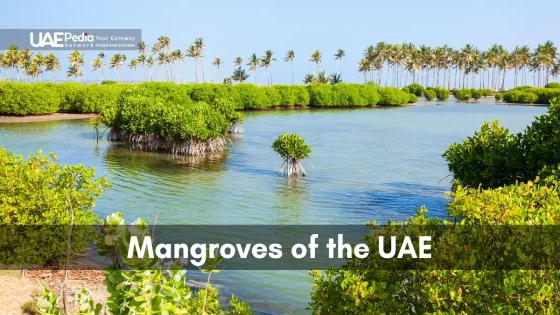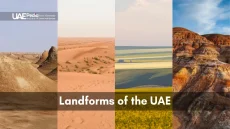What if we told you the region famous for futuristic cities holds ancient deserts older than the Himalayas? While Dubai’s Burj Khalifa grabs headlines, the Emirates’ untamed landscapes whisper stories written in sand dunes and mountain caves.
From rust-red canyons in the Hajar Mountains to the shifting golden waves of the Empty Quarter, this corner of Arabia blends extremes. Coastal mangroves shelter flamingos, while fossil-rich valleys reveal Earth’s history. Even urban hubs like Abu Dhabi hide serene oases where date palms sway like metronomes keeping nature’s rhythm.
This guide isn’t just about checking sites off a list. We’re diving into experiences – tracing Bedouin trails under starry skies, floating in bioluminescent bays, and finding quiet moments in wadis where waterfalls laugh after rare rains. You’ll get practical tips from locals who know when to visit these fragile ecosystems and how to respect their cultural significance.
- Explore seven distinct environments – deserts, peaks, coastlines, and more – within a single day’s drive
- Discover both iconic spots and lesser-known gems missed by typical tours
- Learn how to visit responsibly while supporting conservation efforts
Unearthing the Natural Wonders of the UAE
Picture this: skyscrapers fade in your rearview mirror as you drive toward landscapes shaped over 70 million years. While the Emirates dazzle with urban marvels, their wilder side offers raw beauty that humbles even seasoned travelers. These terrains don’t just exist—they perform, shifting from rust-colored cliffs to salt flats glowing like shattered mirrors under the sun.
What makes these spaces special? They’re living classrooms. You’ll find canyons where rare leopards once prowled and tidal flats where migratory birds stage epic pitstops. Unlike curated city attractions, nature here follows no script—one morning might bring dewdrops on desert lilies, the next a sandstorm rewriting dune patterns.
Adventure thrives in the contrast. Scale Jurassic-era rock formations before lunch, then float in wadi pools by afternoon. Local guides (the real experts) share secrets like moonlight kayaking routes through bioluminescent waters. “The land teaches patience,” says an Ask Aladdin desert explorer. “You don’t conquer it—you sync with its rhythm.”
Balance matters. Rugged hiking trails lead to hidden oases where dragonflies dart between date palms. Families picnic near waterfalls that appear like magic after winter rains. Every visit supports conservation, whether you’re planting mangroves or simply leaving no trace behind.
This isn’t sightseeing—it’s time travel. You’ll walk where ancient traders camped and fossil hunters uncovered prehistoric seas. Pack curiosity, respect, and sturdy shoes. The desert’s waiting to write your story into its ever-changing scroll.
Exploring UAE Natural Landmarks: From Deserts to Mountains
Imagine trading skyscraper views for red-gold dunes that stretch like crumpled silk. Now flip the script – jagged peaks pierce blue skies where ibex leap between cliffs. This is the Emirates’ secret: two worlds collide where endless sands meet stone fortresses older than human memory.
Adventure here wears many hats. Trek across whispering dunes at dawn, then tackle switchback trails in the afternoon. Local guides recommend sunrise hikes when desert temperatures stay playful. “Pack more water than you think,” advises a seasoned trekker from Hatta. “The mountains reward effort but demand respect.”
- Soft sand seas transform into rocky ridges within hours of driving
- High-altitude trails reveal hidden pools and 200-million-year-old fossils
- Full-moon desert walks contrast with technical mountain climbs
Smart explorers layer their experiences. Morning might mean dune bashing in 4x4s, while afternoon brings shaded wadi walks. Evenings? That’s for stargazing sessions where constellations blaze brighter than city lights.
Pro tips: visit Jebel Jais between October-April for crisp hiking weather. Desert enthusiasts prefer winter nights when bonfires crackle under starry skies. Whatever your thrill – quiet contemplation or heart-pounding climbs – these extremes deliver stories you’ll recount for years.
Adventure Across the Deep Deserts and Expansive Dunes
Swap city grids for oceans of sand where dunes rise like frozen waves. The Empty Quarter—Earth’s largest uninterrupted desert—beckons with its hypnotic golden curves. “It’s not just sand,” says a Bedouin guide we met near Big Red. “It’s a living canvas that shifts with every breeze.”
Dune bashing here feels like surfing Earth’s pulse. Skilled drivers tackle slopes at 45-degree angles, tires spitting sand as passengers cheer. Prefer slower thrills? Try sandboarding down 300-foot slopes or camel treks at sunset when shadows stretch like liquid ink.
| Time of Day | Activity | Pro Tip |
|---|---|---|
| Sunrise | Photography & Cool Hikes | Carry electrolyte tablets |
| Midday | Shaded Camp Visits | Avoid metal surfaces |
| Dusk | Dune Bashing | Secure loose items |
Safety first: Drink 1 liter hourly during activities. Wear closed-toe shoes—sand heats to 150°F by noon. Locals swear by lightweight cotton scarves for dust storms. “Your phone dies faster than you in the heat,” warns a Big Red tour operator.
For quieter magic, camp where the Empty Quarter reveals its starriest skies. The silence here isn’t empty—it’s full of ancient whispers. As one adventurer put it: “You don’t conquer these dunes. You dance with them.”
Ready to explore? Check our guide to the top desert vacation spots for hidden gems beyond the tourist trails.
Discovering the Majestic Hajar Mountains
There’s a place where jagged peaks cut through the sky like ancient sentinels. The Hajar range stands defiant against the desert’s golden whispers—a stone fortress where temperatures drop 20 degrees as you climb. Ask Aladdin’s guides call it “the spine of Arabia,” where outdoor thrills meet villages clinging to tradition.
Where Adventure Meets History
Strap on your boots—this is no walk in the park. Trails like Wadi Tayibah’s “Stairway to Heaven” challenge even seasoned hikers with 2,000-foot ascents. Rock faces near Jebel Jais test climbers with limestone pockets and overhangs. Local outfitters offer gear rentals and safety briefings: “Always check weather apps,” warns a Ras Al Khaimah guide. “Flash floods rewrite trails in minutes.”
Stone Villages & Timeless Tales
Between climbs, discover settlements where time moves slower. Mleiha’s mud-brick homes host coffee ceremonies under date palms. In Wadi Hub, elders share stories of trading frankincense along mountain passes. Don’t miss Friday markets—bargain for hand-woven carpets and saffron-infused karak chai.
- Best seasons: October-April (cool mornings, crisp nights)
- Must-pack: UV-protection shirts, grippy shoes, electrolyte gels
- Local secret: Hire a Bedouin guide to find hidden petroglyphs
This range doesn’t just thrill—it teaches. You’ll learn why villagers built aflaj irrigation channels and how to spot endangered Arabian tahr goats. As one hiker joked: “The mountains grade your effort. A+ views require B+ sweat.”
Coastal Charms: Beaches, Waters, and Marine Adventures
Ever dipped your toes in water so clear it feels like swimming in liquid sapphire? The eastern coastline near Fujairah holds secrets where coral gardens meet powder-soft sands. Here, modern marinas sit beside fishing villages unchanged for generations—a harmony of progress and tradition.
Snorkeling and Diving Hotspots
Snoopy Island’s underwater theater steals the show. Schools of parrotfish dart through rainbow corals while hawksbill turtles glide past like living submarines. Local dive masters whisper about night dives where bioluminescent plankton sparkle like submerged constellations. “The sea here doesn’t just dazzle—it performs,” says a Fujairah-based instructor.
| Location | Activity | Best Time |
|---|---|---|
| Dibba Rock | Drift Diving | April-October |
| Shark Island | Reef Exploration | Year-Round |
| Al Aqah Beach | Snorkeling Tours | November-March |
Hidden Coastal Retreats and Activities
Swap yacht crowds for Khor Fakkan’s crescent bay, where families picnic under coconut palms. Kayak through mangrove forests near Yas Island at dawn—watch herons spear breakfast as sunlight paints the waters gold. Don’t miss Friday fish markets in Kalba; vendors grill freshly caught hamour while sharing tales of pearl divers past.
- Insider tip: Visit between October-March for calm seas and 75°F waters
- Try pearl-farm tours to learn Bedouin diving techniques
- Pack reef-safe sunscreen—many areas protect endangered marine life
“Our coastline isn’t just pretty—it’s a living storybook. Every tide pool has a chapter.”
From jet-ski adventures to sunset dhow cruises, these shores blend thrill with tranquility. Whether you’re hunting Instagram-worthy beauty or quiet moments with nature, the waters here promise memories that outlast footprints in the sand.
Oases & Timeless Irrigation Systems in the UAE
Walk through a green cathedral of date palms where desert heat fades to whispers. These lush pockets—some over 3,000 years old—served as vital crossroads for ancient traders and modern families alike. Al Ain Oasis, a UNESCO World Heritage Site, still thrives with 147,000 trees fed by ingenious water channels called aflaj.
Engineering Survival in the Sand
Traditional falaj systems work like nature’s plumbing. Gravity pulls mountain springwater through underground tunnels to nourish crops—no pumps required. Communities once guarded these lifelines like bank vaults. “A working falaj meant survival,” explains a cultural guide in Al Ain. “It turned sand into supper.”
Today, shaded walking trails wind past date varieties with names like Khalas and Lulu. Visitors spot farmers climbing trunks with rope harnesses to pollinate flowers by hand. The air hums with bees drawn to sticky-sweet sap.
| Trail Name | Features | Pro Tip |
|---|---|---|
| Palm Circle Route | Interactive falaj models | Visit at 8 AM for cooler temps |
| Heritage Loop | Date-tasting stations | Wear closed-toe shoes |
These green sanctuaries offer more than shade. They’re living museums where ancient wisdom meets modern conservation. Local schools host workshops on restoring aflaj channels—because in the desert, water knowledge is home security.
Ready to swap skyscrapers for palm fronds? Pack a hat, curiosity, and respect for the hands that built these emerald islands. As one farmer told us: “The desert remembers who tends it.”
Wildlife Sanctuaries and National Reserves
What if your next safari didn’t require flying to Africa? Across sunbaked plains and mangrove-fringed islands, protected spaces shelter rare creatures thriving against the odds. These reserves aren’t just parks—they’re arks preserving genetic treasures like the Arabian oryx and hawksbill turtle.
Observing Endangered Arabian Species
Sir Bani Yas Island rewrites the desert narrative. Once a royal retreat, this 87-square-kilometer sanctuary now hosts free-roaming cheetahs and gazelles. Guides whisper tips: “Sundown drives reveal sand cats’ glowing eyes. Dawn? That’s when flamingos paint the lagoons pink.”
At Al Hefaiyah Mountain Conservation Centre, Nubian ibex scale cliffs like furry rock climbers. Rangers teach visitors to spot tracks—a jerboa’s hop leaves tiny exclamation marks in the sand. Remember: binoculars beat selfie sticks here. “These animals aren’t performers,” reminds a Sharjah conservationist. “We’re guests in their home.”
Conservation Efforts and Eco-Tours
Reserves blend science with adventure. Kayak through mangrove channels shaped by ocean currents while learning replanting techniques. Night safaris on Bani Yas Island track endangered species using thermal cameras—you’ll collect data alongside biologists.
| Reserve | Key Species | Best Visit Time |
|---|---|---|
| Ras Al Khor | Flamingos | November-March |
| Wadi Wurayah | Arabian Tahr | December-February |
| Bu Tinah Island | Dugongs | Closed to public |
“Conservation here isn’t a hobby—it’s survival. Every rescued animal writes hope into our ecosystem’s story.”
Smart visits matter. Wear neutral colors, silence phones, and support local NGOs. Many reserves offer “voluntourism” programs—help tag sea turtles or monitor bird nests. Your visit funds anti-poaching patrols and habitat restoration. As one ranger grinned: “Leave only footprints. Take only memories. And maybe a few photos.”
Dubai’s Natural Attractions: Wadi Ghalilah and Big Red Sand Dune
Think Dubai’s all glass towers and gold souks? Two wild escapes rewrite the script. North of the city, Wadi Ghalilah’s rocky gorges challenge hikers, while Big Red’s dunes roar with adrenaline. These aren’t postcard backdrops—they’re playgrounds where earth and sky dare you to play.
Thrilling Hiking and Dune Bashing Experiences
Wadi Ghalilah’s trails bite back. Loose gravel crunches underfoot as you scramble over boulders shaped by centuries of flash floods. Local guides recommend sunrise starts: “Beat the heat, and you’ll beat the crowds,” says a Ras Al Khaimah trek leader. Pack gloves—the final ascent requires gripping razor-edged limestone.
Big Red delivers a different rush. Skilled drivers tackle 150-foot dunes in 4x4s, tires spitting sand as passengers grip overhead handles. Prefer DIY thrills? Rent a sandboard and surf slopes that glow copper at sunset. Between rides, camel treks offer slower-paced magic—their loping gait syncs with the desert’s heartbeat.
- Start hikes before 7 AM—summer temps hit 110°F by noon
- Book certified operators for dune bashing (check insurance coverage)
- Hydrate hourly: 1 liter per person every 90 minutes
Smart adventurers layer experiences. Tackle Wadi Ghalilah’s ridges at dawn, then cool off with quad biking tours as shadows stretch across Big Red. As one visitor grinned: “Dubai’s wild side doesn’t whisper—it shouts. And you’ll want to shout back.”
Abu Dhabi’s Pristine Wetlands and Mangrove Trails
Beyond the city’s buzz lies a sanctuary where roots dance underwater. Abu Dhabi’s mangrove forests form living labyrinths—carbon-absorbing superheroes that shelter flamingos and filter coastal waters. These salt-tolerant forests aren’t just pretty; they’re climate warriors protecting shorelines while hosting 60+ bird species.
Al Wathba Wetland Reserve stars in this green show. Winter transforms it into a pink-hued stage for greater flamingos. Local guides recommend binoculars: “Look for ospreys diving at sunrise,” whispers an eco-tour leader. Summer brings ghost crabs scuttling through boardwalk shadows.
| Trail | Features | Best Time |
|---|---|---|
| Eastern Mangroves | Kayak paths, bird hides | October-March |
| Al Wathba Boardwalk | Flamingo sightings | November-April |
Time your visit with high tide for kayaking through emerald channels. Low tide? That’s when mudskippers—those comic fish-amphibians—put on their mud-flipping show. Pack reef-safe sunscreen and a waterproof phone case.
These wetlands offer more than escape. They’re classrooms where conservation meets wonder. Join guided paddles to plant mangrove saplings or photograph herons mid-strike. As one biologist noted: “Every root here holds a story—and an answer to climate challenges.”
“Twenty minutes from downtown, you swap traffic for tidal rhythms. It’s therapy with fins and feathers.”
Ready to trade skyscrapers for spoonbills? Sunrise tours reveal nature’s quiet power, while full-moon paddles light the waters silver. Abu Dhabi’s wild side waits—no safari hat required.
Exploring Hatta: Mountains, Dams, and Scenic Trails
Crave switchbacks with mountain views on one side and glassy waters below? Hatta’s rugged peaks cradle turquoise reservoirs like jewels in a stone crown. This adventure hub blends raw geology with human ingenuity—an outdoor playground where 19th-century watchtowers overlook modern thrill-seekers.
Mountain Biking and Kayaking Adventures
Pedal through history on trails that twist past ancient villages. The Hatta MTB Trail Network offers routes for all skill levels—beginners cruise smooth paths by the dam, while experts tackle the Black Trail’s heart-pumping drops. Local outfitters recommend early starts: “Tires grip better when rocks are cool,” says a guide at Hatta Wadi Hub.
Prefer waterborne thrills? Kayak across Hatta Dam’s mirror-like surface, where dragonflies dart between your paddle strokes. Sunset tours reveal mountains painted in burnt orange hues—quiet moments between adrenaline bursts.
| Trail | Features | Pro Tip |
|---|---|---|
| Blue Trail | Family-friendly loops | Rent bikes with suspension seats |
| Yellow Trail | Technical rock gardens | Carry a hydration pack |
| Dam Circuit | Waterfront views | Book sunrise slots |
Smart adventurers layer experiences. Tackle the Hatta’s best hiking trails at dawn, then cool off with a kayak session. Pack light layers—temperatures swing 20 degrees between shaded valleys and sunbaked ridges.
- Insider secret: Midweek visits mean empty trails and calmer waters
- Safety first: Helmets mandatory, GPS trackers recommended for solo riders
- Local flavor: Refuel with camel milk ice cream at the Heritage Village
“Hatta doesn’t just challenge your muscles—it feeds your soul. Every turn reveals why our ancestors chose these peaks.”
Historical Landscapes: Jebel Hafit Desert Park and Ancient Tombs
Ever traced your finger along stone carvings older than the Pyramids of Giza? Jebel Hafit Desert Park guards secrets in its dusty folds—beehive tombs whispering tales of Bronze Age traders and forgotten rituals. This rugged terrain isn’t just rocks and sand—it’s a time capsule where every cracked pottery shard rewrites history.
Discovering Bronze Age Artifacts
Archaeologists still buzz about the 5,000-year-old burial chambers dotting these slopes. Inside, they’ve found arrowheads traded from Mesopotamia and beads that journeyed from the Indus Valley. “These weren’t isolated people,” explains a Al Ain-based researcher. “Their date trade routes stretched across continents.”
The park’s jagged rock formations serve as nature’s museum labels. Scramble up fossil-rich ridges to spot ancient tool marks where early inhabitants quarried stone. Evening light paints the cliffs amber—perfect for photographing geometric tomb patterns that mirror constellations.
Smart explorers come prepared:
- Book guided sunrise hikes to avoid midday heat (November-March ideal)
- Pack headlamps for full-moon walks where shadows reveal tomb entrances
- Resist touching artifacts—even oil from skin damages fragile surfaces
Camping here feels like time travel. Pitch your tent where Bronze Age herders slept, then stargaze through the same clear skies they navigated. Morning brings hot coffee and the realization: you’re sipping where civilizations traded spices and stories.
“Jebel Hafit doesn’t just show history—it lets you walk beside it. Every stone here has a voice if you listen.”
Embracing Nature: A Journey Through UAE’s Diverse Beauty
Ever watched sunlight turn sand into liquid gold or traced mountain shadows that change by the minute? The Emirates’ wild spaces unfold like a storybook where every chapter surprises. Rugged peaks guard fossil secrets. Salt flats mirror clouds like nature’s Instagram filter. Mangrove roots cradle baby sharks in nurseries older than skyscrapers.
This land thrives on contrast. One moment you’re sweating up a wadi trail, the next floating in bioluminescent bays that sparkle like Tinker Bell’s workspace. Oases hum with 3,000-year-old irrigation songs while flamingos waltz in tidal ballet. Each scene whispers: “Look closer—wonders hide in plain sight.”
Pack smart—light layers beat heavy jackets when desert nights chill. Time coastal visits with tides to catch herons mid-hunt. Support guides preserving petroglyphs and replanting corals. Whether you seek adrenaline or quiet awe, these landscapes reward those who wander with open eyes and light footsteps.
Ready to write your chapter? Lace up boots, grab reusable bottles, and let curiosity lead. The dunes won’t text you back—but they’ll etch memories deeper than any screen. Beauty here isn’t a backdrop—it’s an invitation to play, learn, and protect. Your adventure starts where the pavement ends.
Aim for October to March when temperatures dip below 30°C (86°F). Early mornings and golden-hour sunsets transform the dunes into glowing waves—perfect for photography or camel treks without the midday heat.
Absolutely! The Arabian Wildlife Park offers guided safari drives where you’ll spot giraffes, gazelles, and cheetahs. Kayak through mangrove channels or bike shaded trails—most tours cater to all ages while respecting animal habitats.
Yes! Trails like Wadi Tayyibah’s palm-filled gorge or Jebel Hafeet’s paved paths offer manageable climbs. For rugged peaks, hire local guides—they’ll share Bedouin navigation tricks and hidden freshwater pools.
Al Ain Oasis’s UNESCO-listed channels still water 147,000 date palms using 3,000-year-old techniques. Wander shaded pathways, then visit the eco-center to see how these aqueducts shaped desert agriculture.
Paddle through serene lagoons where flamingos wade and turtles surface. The Eastern Mangroves boardwalk offers moonlit tours, while Jubail Island’s new trails let you plant mangroves as part of conservation efforts.
Licensed operators provide roll-cage-equipped 4x4s and trained drivers. Morning sessions (cooler sand, fewer crowds) balance adrenaline with safety—just grip those handles and enjoy the rollercoaster-like drops!
Rent e-bikes or join guided kayak groups to minimize environmental impact. Post-rainfall months (January-February) reveal emerald pools, but avoid solo hikes—weather shifts rapidly in these rugged wadis.


















